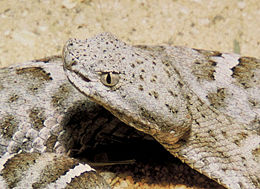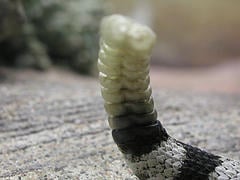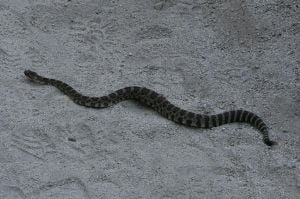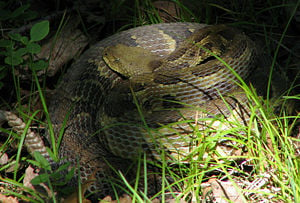Difference between revisions of "Rattlesnake" - New World Encyclopedia
Rick Swarts (talk | contribs) |
Rick Swarts (talk | contribs) |
||
| Line 23: | Line 23: | ||
==Overview== | ==Overview== | ||
| + | elongate, limbless, [[Scale (zoology)|scale]]d, carnivorous [[reptile]]s comprising the suborder Serpentes (or Ophidia) of the order [[Squamata]]. lack movable eyelids, lack external ear openings, and generally lack limbs entirely, although some species have traces of hind limbs. Lizards usually have movable eyelids (although see [[gecko]]s), external ear openings (although see [[chameleon]]s), and most have four-well developed limbs, often with five toes on each foot. Some lizard species, including the [[glass lizard]] and [[Pygopodidae|legless lizards]], lack functional legs although there are some [[vestigial]] structures. These are distinguished from true snakes by the presence of eyelids and ears and a [[tail]] that can sometimes break off as a physical defense mechanism. | ||
| + | |||
| + | In order to accommodate snakes' narrow bodies, paired organs (such as [[kidney]]s) appear one in front of the other instead of side by side. A snake has only one lung functional for breathing. | ||
| + | |||
| + | Snakes are members of the '''''Common names''': pit vipers,<ref name="Meh87">Mehrtens JM. 1987. Living Snakes of the World in Color. New York: Sterling Publishers. 480 pp. ISBN 0-8069-6460-X.</ref> pitvipers.<ref name="C&L04">Campbell JA, Lamar WW. 2004. The Venomous Reptiles of the Western Hemisphere. Comstock Publishing Associates, Ithaca and London. 870 pp. 1500 plates. ISBN 0-8014-4141-2.</ref>'' | ||
| + | The '''Crotalinae''', or crotalines, are a [[subfamily (biology)|subfamily]] of [[venomous snake|venomous]] [[Viperidae|viper]]s found in [[Asia]] and the [[Americas]]. They are distinguished by the presence of a heat-sensing pit organ located between the eye and the nostril on either side of the head. Currently, 18 [[genus|genera]] and 151 [[species]] are recognized:<ref name="ITIS">{{ITIS|ID=634394|taxon=Crotalinae|year=2006|date=26 October}}</ref> 7 genera and 54 species in the [[Old World]], against a greater diversity of 11 genera and 97 species in the [[New World]]. These are also the only [[Viperidae|viperids]] found in the Americas. | ||
| + | |||
| + | [[Image:mexican_ridged_nosed_rattlesnake_head.jpg|thumb|left|260px|The pit organ is clearly visible between the eye and the nostril of this New Mexico ridge-nosed rattlesnake, ''[[Crotalus willardi obscurus]]''.]] | ||
| + | |||
| + | What makes this group unique is that they all share a common characteristic: a deep pit, or fossa, in the loreal area between the eye and the nostril on either side of the head. These pits are sensitive to [[infrared radiation]], in effect giving the snakes a sixth sense that helps them to find and perhaps even judge the size of the small warm-blooded prey on which they feed.<ref name="C&L04"/> | ||
| + | |||
| + | |||
| + | |||
| + | The '''Viperidae''' are a family of [[venomous snake]]s commonly referred to as '''vipers''', although the term '''viperids''' is more specific and distinguishes them from the viperines (subfamily ''[[Viperinae]]''). These snakes are found all over the world, except in [[Australia]] and [[Madagascar]]. All have relatively long hinged fangs that permit deep penetration and injection of [[venom]]. Four subfamilies are currently recognized.<ref name="ITIS">{{ITIS|ID=174294|taxon=Viperidae|year=2006|date=10 August}}</ref> | ||
| + | |||
| + | All viperids have a pair of relatively long [[Solenoglypha|solenoglyphous]] (hollow) fangs, that are used to inject [[venom]] from glands located towards the rear of the upper jaws. Each of the two fangs is at the front of the mouth on a short [[maxillary]] bone that can rotate back and forth. When not in use, the fangs fold back against the roof of the mouth and are enclosed in a membranous sheath. The left and right fangs can be rotated together or independently. During a strike, the mouth can open nearly 180° and the [[maxilla]] rotates forward, erecting the fang. The jaws close on impact and powerful muscles that surround the venom glands contract to inject the venom as the fangs penetrate. This action is very fast; in defensive strikes it can be more a stab than a bite. Viperids use this mechanism both to immobilize their prey and in self-defense. | ||
| + | |||
| + | |||
| + | |||
| + | |||
There are approximately fifty [[List of rattlesnake species and subspecies|species of rattlesnake]], with numerous subspecies. They receive their name for the [[rattle]] located at the tip of their tails. The rattle is used as a warning device when threatened. The scientific name ''Crotalus'' derives from the [[Greek language|Greek]], ''κρόταλον'', meaning "[[castanet]]". The name ''Sistrurus'' is the [[Latin language|Latinized]] form of the [[Greek language|Greek]] word for "tail rattler" (''Σείστρουρος, Seistrouros'') and shares its root with the ancient [[Egypt]]ian musical instrument, the [[sistrum]], a type of rattle. | There are approximately fifty [[List of rattlesnake species and subspecies|species of rattlesnake]], with numerous subspecies. They receive their name for the [[rattle]] located at the tip of their tails. The rattle is used as a warning device when threatened. The scientific name ''Crotalus'' derives from the [[Greek language|Greek]], ''κρόταλον'', meaning "[[castanet]]". The name ''Sistrurus'' is the [[Latin language|Latinized]] form of the [[Greek language|Greek]] word for "tail rattler" (''Σείστρουρος, Seistrouros'') and shares its root with the ancient [[Egypt]]ian musical instrument, the [[sistrum]], a type of rattle. | ||
| Line 106: | Line 126: | ||
[[Category:Animals]] | [[Category:Animals]] | ||
[[Category:Reptiles]] | [[Category:Reptiles]] | ||
| − | {{credit|Rattlesnake|178023091}} | + | {{credit|Rattlesnake|178023091|Crotalinae|176273167|Viperidae|177228774}} |
Revision as of 16:01, 15 December 2007
| Rattlesnake | ||||||||||||||||||
|---|---|---|---|---|---|---|---|---|---|---|---|---|---|---|---|---|---|---|
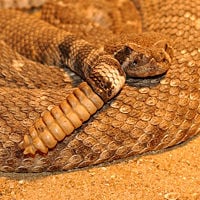 | ||||||||||||||||||
| Scientific classification | ||||||||||||||||||
| ||||||||||||||||||
|
27 species; see list of rattlesnake species and subspecies. |
Rattlesnake is the common name for any of the venomous snakes comprising the genera Crotalus and Sistrurus of the pit viper subfamily Crotalinae and the viper family Viperidae, characterized by a triangular head, a heat-sensing pit organ located between the eye and the nostril on either side of the head, and a rattle at the end of the tail. The rattle consists of a series of horny, hollow segments of skin, loosely attached, that can be vibrated or shaken to make a rattling or buzzing sound.
Overview
elongate, limbless, scaled, carnivorous reptiles comprising the suborder Serpentes (or Ophidia) of the order Squamata. lack movable eyelids, lack external ear openings, and generally lack limbs entirely, although some species have traces of hind limbs. Lizards usually have movable eyelids (although see geckos), external ear openings (although see chameleons), and most have four-well developed limbs, often with five toes on each foot. Some lizard species, including the glass lizard and legless lizards, lack functional legs although there are some vestigial structures. These are distinguished from true snakes by the presence of eyelids and ears and a tail that can sometimes break off as a physical defense mechanism.
In order to accommodate snakes' narrow bodies, paired organs (such as kidneys) appear one in front of the other instead of side by side. A snake has only one lung functional for breathing.
Snakes are members of the Common names: pit vipers,[1] pitvipers.[2] The Crotalinae, or crotalines, are a subfamily of venomous vipers found in Asia and the Americas. They are distinguished by the presence of a heat-sensing pit organ located between the eye and the nostril on either side of the head. Currently, 18 genera and 151 species are recognized:[3] 7 genera and 54 species in the Old World, against a greater diversity of 11 genera and 97 species in the New World. These are also the only viperids found in the Americas.
What makes this group unique is that they all share a common characteristic: a deep pit, or fossa, in the loreal area between the eye and the nostril on either side of the head. These pits are sensitive to infrared radiation, in effect giving the snakes a sixth sense that helps them to find and perhaps even judge the size of the small warm-blooded prey on which they feed.[2]
The Viperidae are a family of venomous snakes commonly referred to as vipers, although the term viperids is more specific and distinguishes them from the viperines (subfamily Viperinae). These snakes are found all over the world, except in Australia and Madagascar. All have relatively long hinged fangs that permit deep penetration and injection of venom. Four subfamilies are currently recognized.[3]
All viperids have a pair of relatively long solenoglyphous (hollow) fangs, that are used to inject venom from glands located towards the rear of the upper jaws. Each of the two fangs is at the front of the mouth on a short maxillary bone that can rotate back and forth. When not in use, the fangs fold back against the roof of the mouth and are enclosed in a membranous sheath. The left and right fangs can be rotated together or independently. During a strike, the mouth can open nearly 180° and the maxilla rotates forward, erecting the fang. The jaws close on impact and powerful muscles that surround the venom glands contract to inject the venom as the fangs penetrate. This action is very fast; in defensive strikes it can be more a stab than a bite. Viperids use this mechanism both to immobilize their prey and in self-defense.
There are approximately fifty species of rattlesnake, with numerous subspecies. They receive their name for the rattle located at the tip of their tails. The rattle is used as a warning device when threatened. The scientific name Crotalus derives from the Greek, κρόταλον, meaning "castanet". The name Sistrurus is the Latinized form of the Greek word for "tail rattler" (Σείστρουρος, Seistrouros) and shares its root with the ancient Egyptian musical instrument, the sistrum, a type of rattle.
Most rattlesnakes mate in the spring. All species give live birth, rather than laying eggs. The young are self-sufficient from birth. As they do not need their mother after birth, the mother does not remain with her young.
Prey
Rattlesnakes consume rodents and other small animals, such as rabbits, rats, mice, etc., subduing their prey quickly with a venomous bite as opposed to constricting. The venom stuns or kills typical rattlesnake prey immediately. A rattlesnake will follow prey that does not quickly succumb to the venom and attempts to escape. They are specially known to strike at distances up to two-thirds their body length.
Predators
Rattlesnakes are prey for kingsnakes, roadrunners, pigs, hawks, and eagles. They have been harvested as human food, such as at the Rattlesnake Round-Up in Sweetwater, Texas.
The rattle
The rattle is composed of a series of nested, hollow beads which are actually modified scales from the tail tip. Each time the snake sheds its skin, a new rattle segment is added. They may shed their skins several times a year depending on food supply and growth rates. The rattle may break; there is little truth to the claim that one can tell a rattlesnake's age from the number of beads in its rattle. Newborn rattlesnakes do not have functional rattles; it isn't until after they have shed their skin for the first time that they gain an additional bead, which beats against the first bead, known as the button, to create the rattling sound. Adult snakes may lose their rattles on occasion, but more appear at each molting. If the rattle absorbs enough water in wet weather, it will not make noise.
Paleontology
The earliest fossil found which can be definitively identified as a rattlesnake was discovered near Driftwood Creek in Hitchcock County, Nebraska, U.S.A. An exact age of the specimen is indeterminate. The fossilized remains usually consist of ribs, which makes accurate specie identification problematic, as even many species of modern rattlesnakes have nearly identical vertebral characteristics. One extinct species, of which fossils were discovered in Allen Cave in Citrus County, was given the name Croeus. Though it had many characters in common with the modern Crotalus adamanteus, it was a much larger animal, probably attaining lengths in excess of 12 feet. In general, the fossil record for rattlesnakes is quite limited, and their exact route of evolution from the more primitive true vipers to their current form is not well understood.[4]
Safety and identification
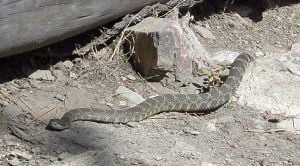
Different species of rattlesnake vary significantly in size, territory, markings, and temperament. If the rattlesnake is not cornered or imminently threatened, it will usually attempt to flee from encounters with humans, but will not always do so. Bites often occur when humans startle the snake or provoke it. Those bitten while provoking rattlesnakes have usually underestimated the range (roughly two-thirds of its total length) and speed with which a coiled snake can strike (literally faster than the human eye can follow). Be aware that they can actually strike without pulling their body back into the famous "S" coil shape first and they may strike without any warning if feeling threatened. Heavy boots and long pants reinforced with leather or canvas are recommended when hiking in areas known to harbor rattlesnakes.
For learning how to quickly and safely identify rattlesnakes by their markings, guides are available through booksellers, libraries, and local conservation and wildlife management agencies. The best way to avoid contact with rattlesnakes is to remain observant and avoid potential encounters. Hikers should always watch their steps when negotiating fallen logs or boulders and take extra caution when near rocky outcroppings and ledges where rattlesnakes may be hiding or sunning themselves. Snakes will occasionally sun themselves in the middle of a trail, so always watch your step. When encountering a rattlesnake on a trail, keep your distance and allow the snake room to retreat. Pets should be kept leashed to prevent them from provoking a rattlesnake.
Rattlesnake bites
Rattlesnakes are born with fully functioning fangs capable of injecting venom and can regulate the amount of venom they inject when biting. Generally they deliver a full dose of venom to their prey, but may deliver less venom or none at all when biting defensively. A frightened or injured snake may not exercise such control. Young snakes, although incapable of delivering an amount of venom equivalent to their adult counterparts, are still potentially deadly. Any bite must be considered dangerous and professional medical care should immediately be sought.
Toxicity
Most species of rattlesnakes have hemotoxic venom, destroying tissue, degenerating organs and causing coagulopathy (disrupted blood clotting). Some degree of permanent scarring is very likely in the event of a venomous bite, even with prompt, effective treatment, and a severe envenomation, combined with delayed or ineffective treatment, can lead to the loss of a limb and rarely, death. Thus, a rattlesnake bite is always a potentially serious, or even fatal, injury. Untreated rattlesnake bites, especially from larger species, are very often fatal. However, antivenin, when applied in time, reduces the death rate to less than 4%. Around 8,000 people are bitten by venomous snakes in the United States each year[1]. On average, fewer than 15 snakebite deaths are reported.
Some rattlesnakes, especially the tropical species, have neurotoxic venom. A bite from these snakes can interfere with the function of the heart, paralyze the lungs, and shut down parts of the nervous system.
First aid
When a bite occurs, the amount of venom injected cannot be gauged easily. Symptoms and swelling may occur quickly,and may cause death easily but in some cases hours may pass before serious effects appear.
Experienced health workers typically gauge envenomation in stages ranging from 0, when there is no evident venom, to 5, when there is a life-threatening amount of venom present. The stages reflect the amount of bruising and swelling around the fang marks and the speed with which that bruising and swelling progresses. In more severe envenomation cases (stage 4 or 5) there may also be proximal symptoms, such as lip-tingling, dizziness, bleeding, vomiting, or shock. Difficulty breathing, paralysis, drooling, and massive hemorrhaging are also common symptoms.
If you're bitten by a rattlesnake and you have someone with you, make him/her get a docter as soon as possible because running makes your blood pump and the venom the rattlesnake injects goes into your blood stream while your blood pumps the venom also spreads faster.
Quick medical attention is critical, and treatment typically requires antivenin/antivenom to block the tissue destruction, nerve effects, and blood-clotting disorders common with rattlesnake venom, Most medical experts recommend keeping the area of the bite below the level of the heart. It is important to keep a snake bite victim calm in order to avoid elevating their heart rate and accelerating the circulation of venom within the body. Untrained individuals should not attempt to make incisions at or around bite sites, or to use tourniquets, as either treatment may be more destructive than the envenomation itself.
Any bite from a rattlesnake should be treated as a life-threatening medical emergency that requires immediate hospital treatment from trained professionals.
Rattlesnakes as food
Rattlesnakes are also a popular food in some southwestern cuisines and are sometimes sold in specialty meat shops. It has a flavor that has been described as similar to chicken or frog legs and a chewy texture similar to alligator.[2]
Rattlesnakes in captivity
There are fairly obvious risks with private ownership of rattlesnakes. A bite can result in a large bill [3] for emergency medical care. Some jurisdictions outlaw the possession of venomous snakes. Where it is legal, some form of license or insurance policy may be required.
Media
|
|||||
| Problems listening to this file? See media help. | |||||
See also
- List of rattlesnake species and subspecies
ReferencesISBN links support NWE through referral fees
- ↑ Mehrtens JM. 1987. Living Snakes of the World in Color. New York: Sterling Publishers. 480 pp. ISBN 0-8069-6460-X.
- ↑ 2.0 2.1 Campbell JA, Lamar WW. 2004. The Venomous Reptiles of the Western Hemisphere. Comstock Publishing Associates, Ithaca and London. 870 pp. 1500 plates. ISBN 0-8014-4141-2.
- ↑ 3.0 3.1 Crotalinae (TSN 634394). Integrated Taxonomic Information System. Accessed on 26 October 2006. Cite error: Invalid
<ref>tag; name "ITIS" defined multiple times with different content - ↑ Klauber, Laurence M. 1956. Rattlesnakes, Their Habits, Life Histories, and Influence on Mankind. Volume I. Second E
- Manny Rubio; Rattlesnake: A Portrait of a Predator; Smithsonian Institute Press; ISBN 1-56098-808-8 (hardcover, 1998)
- R. Burton, MD; Emergency Medicine. Lectures on Venom and Toxins. 1989.
External links
- J. Jones, MD; Dispelling The Snakebite Myth
- Rattlesnakes: A Species Photo Index
- Desert USA article
- American International Rattlesnake Museum Albuquerque, New Mexico
- Rattlesnakes of Arizona Good descriptions of many species with ranges
- Victim's account of rattlesnake bite - Crotalus atrox
- Wife's account of the same Crotalus atrox bite
- Victim's account of rattlesnake bite - Crotalus scutulatus
- Victim's account of rattlesnake bite - Crotalus horridus
Credits
New World Encyclopedia writers and editors rewrote and completed the Wikipedia article in accordance with New World Encyclopedia standards. This article abides by terms of the Creative Commons CC-by-sa 3.0 License (CC-by-sa), which may be used and disseminated with proper attribution. Credit is due under the terms of this license that can reference both the New World Encyclopedia contributors and the selfless volunteer contributors of the Wikimedia Foundation. To cite this article click here for a list of acceptable citing formats.The history of earlier contributions by wikipedians is accessible to researchers here:
The history of this article since it was imported to New World Encyclopedia:
Note: Some restrictions may apply to use of individual images which are separately licensed.
